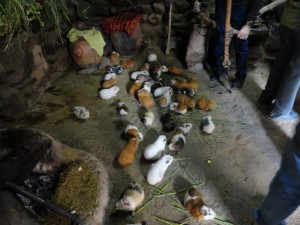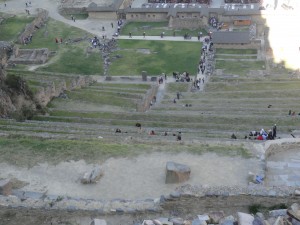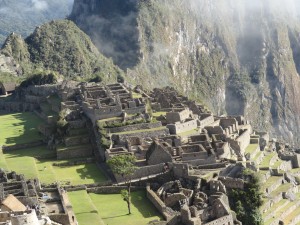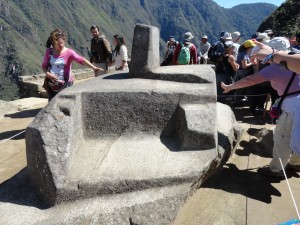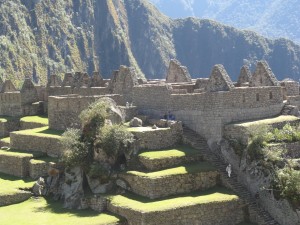Every morning since we got into this (extremely clean) hostel on Plaza de San Blas, at about 7 am, we’ve been awakened by the sound of exploding sticks of dynamite followed by very bad marching band music. There’s always something going on in this little square here and it seems that these particular explosions as well as the bad music is a tribute to Santa Carmen. I’ve never heard of Santa Carmen and being Italian, you’d think I would’ve heard of Santa Carmen since Italians say novenas to every saint under the sun—Pray to Saint Ann if you want a man, Saint Jude is the patron saint of lost causes, etc. and so forth—but Santa Carmen? I’ve never heard of her, but it seems like she’s an iteration of the Virgin. Anyway they totally dig her and have been celebrating her birthday. (I think it’s all about her birthday since I keep hearing an awful horn player playing Happy Birthday.) (Being a Saint and all, one might assume she should at least have a better horn section.) Yesterday, they built these huge and rickety looking structures out of what looked like bamboo, and they did something with them, I don’t know what though. We were at dinner when whatever was supposed to happen happened. (While we were waiting for our table, we spoke with this delightful French woman. She lives in Sante Fe but has a business where she conducts shaman and spiritual tours for French people down here in South America. She’s carved out quite an impressive niche for herself. Her website is santefecoaching.com. We told her about the structures and she high-tailed up to San Blas to see what it was. I hope we bump into her again so I can ask her what happened.) Anyway, after a truly fabulous meal, and I mean wow, it was good (I had some sort of native potato gnocchi with a creamy pumpkin sauce) we headed back up to the hostel at about 10 pm and found a ton of people singing and dancing in the street outside of the church that is practically next door to our hostel. There was, however, no trace of the big rickety things.
I may be a decent writer, but there is no way what I’m about to describe will in any way convey just how surreal that night was.
So, there was a bunch of people, maybe 50 or 60, standing around and a giant mess of cakes was on a table outside of this tiny church. Inside the very small church was another bunch of people, around 20 or so, and a mariachi band playing typical mariachi type music, including Happy Birthday. Peter and I went inside and sat down and we were sort of digging the music with everybody else. People were dancing and clapping and really having a much better time than I’m used to seeing inside a Roman Catholic church. After about thirty minutes or so, the band moved outside and all the people went outside as well. Then another band started to play that horsy galloping music and people started to dance in the street. A lot of folks were just standing around drinking beer and chicha (the spit corn beer), there were a lot of food vendors selling this or that and couple of people in costume and masks sort of being goofy and dancing. So, of course, we started to dance too. At some point, the costumed people cut in and I was dancing with a rather tiny masked man and Peter was dancing with a rather large masked woman… or so he thought it was a woman. Heh, heh, heh. Anyway, that went on for a while and every now and then, a car would try to get through the street and we’d all just dance around them, giving them a hard time but eventually allowing them to pass. Most of them were amused by the shenanigans. Only one or two of the drivers scowled at us. The music just went on and on, people just kept dancing and dancing and drinking and eating, and far be it from me to not mention that the street was all wet and smelled like damp horse poo. I don’t know, at some point, Peter found someone to pour him some beer and then he started drinking with the locals and I started to get really tired. I think I gave up at about 1 am and he came in about twenty minutes later. When I left, he was deep in conversation with this guy with funny teeth. I have no idea what either of them was saying, but I’m also pretty sure Peter didn’t know what the conversation was about either. (He says he knew, but that he just couldn’t remember…. And I’m not sure what’s worse.)
Dancing in the street in the middle of the night with a bunch of Peruvians. That was something. I’m not sure what, but it was definitely something.
The next day, we woke up late and sort of wandered around looking for a Turkish bath. Peter is now hooked on Turkish baths. I’m not all that into them so he went by himself, which is why I have the time to write.
The next day, we started our journey to Machu Picchu. It’s sort of a long drawn out process. Even buying the tickets was tricky. The absolute cheapest way to go is by bus, but that takes 11 hours. It’s a very circuitous route but it passes through a bunch of towns and different climates and is probably pretty damn cool. But we didn’t do that. The most expensive way to go is to take a train all the way from Cusco to Aguas Calientes. Obviously, we didn’t do that either. The middle way is to take a bus to Ollantaytambo and then take the train to Aguas Calientes from there. This being peak season and all, we had to use two different train companies, which meant we had to buy tickets one way from Peru Rail and then return on Inca Rail. Peru Rail is about $15 USD less than Inca Rail. There’s not too much difference between the trains. The seats are cushier on Inca Rail, they pipe in Peruvian Muzak and their snacks are of a far better quality, but that’s it. Other than that, it’s all the same.
Peter’s friend Patrick was not up to taking a bus, so we took a cab to Ollantaytambo, which cost around $20 USD for all of us. The bus would’ve been a bit cheaper but way less direct. Our train didn’t leave Ollantaytambo (I just LOVE to type that) until 7 pm so we had some time to kill. Ollantaytambo is a lovely little city that pretty much looks the same as when the conquistadors left it, even more so than Cusco. It’s the one place where the Incas actually won a battle against the invading Spanish. There’s a huge fortress that looks over the city and I guess Manco Inca threw stuff at the Spanish and flooded the area below to get rid of them. It worked, once. The Spanish then came back and destroyed them.
We walked around a bit. One place was sort of a living museum and a market. We overheard a tour guide saying the hut was set up as it would’ve been when the Incas were there. It was very dark with what looked like desiccated goat carcasses hanging from the rafters. There were a few altar-looking things with skeleton heads. One of the skeletons had a cigarette in its mouth. The guide said that it was some Incan god and the people believed he liked a smoke every now and again so two or three times a week, they’d put a cigarette in its mouth. They had an open fire with a big cast iron pot on it and tons of guinea pigs were on the floor The guide explained that the guinea pigs were chickens, not pets. I don’t know if you’ve ever heard a mess of guinea pigs but the little cooing noises they make, en masse, sounds a lot like the tribbles from “Star Trek.” We didn’t want to hang out too long in the houses or even take that many pictures (like the rest of the American tourists were doing) because we felt like it was exploitative.
Peter and Patrick went back down to the square to hang out and Marcy and I went to the Incan fortress. It only cost around $25 USD for the both of us. It was pretty cool, not as cool as Machu Picchu, but it was cool. Some of the stonework was intact and you can see how the stoneworkers made the stones fit and the fact that hundreds of years later, you still can’t slide a piece of paper in between any of the stones is pretty amazing.
Also, the stones aren’t all square. Each stone is individually cut, some with more than four sides. I don’t know how they did it. You’ll notice from the pictures that all the Incan sites are on cliff sides with terracing. I overheard yet another tour guide talking about how the Incans used the terraces as microclimates. I don’t know squat about farming or anything but I’m not convinced it has to do with microclimates. Seems to me, and it’s just my ignorant opinion, that the terracing is the most logical way to farm on a friggin’ cliff side and nothing more. I think anthropologists just make crap up because they have papers to write.
Anyway, Marcy and I learned one very important lesson: Going up is way easier than going down. Later, we all had a great lunch at a place called Hearts Cafe that funnels all its profits to feeding and helping Andean women and kids who live in remote villages. The British woman who owns it started her own NGO to do the work. (If you’re a donating type of person, the website is livingheartperu.org) After our late lunch, we headed over to the train station and off we went to Aguas Calientes.
We arrived at around 9 pm and we parked Marcy and Patrick while we ran around the town looking for a place to stay. The train was packed and we knew we were going to have a hard time arriving so late. Peter insisted on hitting the Lonely Planet recommendations, but I knew that they would all be filled by other Lonely Planet people who had arrived much earlier than we had. He was insistent however and after several places said they were full, he began to listen to me. We walked all over the tiny, ugly little town and finally found a decent place that was off the beaten path for $80 soles. Aguas Calientes is town that has been completely destroyed by tourism. Every place is either an overpriced restaurant or hotel or hostel. Every. Single. Place. Everywhere you looked were tourists, mostly young Americans, but tons of German and French too. It might’ve been a nice place once. It has hot springs, has a lovely rolling river that runs through it, lost of bridges and is at the base of Machu Picchu, but now, it’s devoid of culture. It’s one of the crappiest places I’ve ever been, probably also one of the most dangerous. Peter was hyper aware of being watched. I was coming down with a cold (which got better quick thanks for the curazinc, mom) so Peter went out to look around while I climbed into bed. He was back in about 15 minutes. He didn’t even have a beer. He was as disgusted as I was.
We had planned on waking up around 4:30 am so we could hike up to Machu Picchu instead of taking the bus, but sleeping was very difficult. The streets were noisy and the town was having their own Santa Carmen celebration. The damn band was marching around the streets playing (badly played) music until three or four in the morning! Add to that the fact that I somehow screwed up my phone so the alarm didn’t sound and we woke up two hours late. I was pissed. I mean REALLY pissed. I wanted to be totally chill when I got my first glimpse of Machu Picchu and that was not going to be possible. We got dressed as fast as we could and ran down to where we had to buy our tickets. There was already a huge line and I was beginning to hate people. I decided to step away from the line and buy some coffee and the guy tried to rip me off. After he made the coffee, he told me it was $25 soles (which is like over $8 USD) and I was all “Hell no” and I gave him a ten and left. I went back to the line and the longer we waited, my misanthropic attitude worsened. After that line, we had to stand in another line for bus tickets. We no longer had time to make the hike up because our train left at 2 pm. That bus line would’ve been comical had I not been homicidal. People were cutting in, asking stupid questions, the ticket agent was slow as molasses, and it was all unbelievable. It was such a third world cliché. After that line, we had to wait in another line to get on the bus. The bus was nice an all, but it made me feel bad. It was just bus after bus after bus, loaded with tourists. The road was made and maintained by locals who couldn’t even afford to visit Machu Picchu, which actually belongs to them, if anybody. I found myself wishing I hadn’t been such a self-centered dummy when I was in college so that I could’ve been to Machu Picchu before it got all ugly and touristy. (And before my knees sounded like castanets.)
We get to the top and had to stand in another line to get into Machu Picchu. We could’ve chosen to stand in another line after that to leave our bags in a locker, but we had enough of the lines. We took off. And then we saw it.
You know, I’ve always known about Machu Picchu. I’d seen the pictures in magazines at the dentist’s office or the doctor’s office and was always like, “Wow, that’s lovely. I wonder if I’ll ever see that.” And then I’d put the magazine down when my name was called and that’s about all I ever thought about it. It was always this sort of, well, that would be nice, but impossible sort of thing. And that’s why I cried a little when I saw it.
The pictures don’t do it justice. The clouds, the mountains, the terracing, the buildings, the stones, you can’t take a bad picture of it. It’s awe-inspiring. And nobody even knows what it was for. Was it a religious retreat or an elite getaway? Nobody has a clue really. What they’re pretty sure of is that it was abandoned before the Spanish arrived and that would explain why it was basically undiscovered (by white people) for so long.
For one brief moment, I took it all in, but then, at some point, the voices start creeping in and I realized that people were surrounding me. We were not alone in this place that had been alone for hundreds of years.
And that’s why I think Machu Picchu is one of the saddest places on earth.
This grand and magnificent place doesn’t belong to the people who live here. Most Peruvians can’t even afford to get in, even at the reduced prices. And the people who go there are tourists. Most of them want an easy way in, an easy way around, food to eat, pictures to take and bragging rights for having gone. It was cheesy, commercialized, and devoid of any depth. We saw one tourist holding up a t-shirt that said “I (heart) Machu Picchu” or something ridiculous. It was a f-cking t-shirt! There was a spot that was more or less a large timepiece but some tour guide said something about it also having some “religious energy” and that people weren’t supposed to touch it and sure enough, a bunch of them had to touch it. “Ooo, I feel it! Marge! Come here! You have to try this!” Yeah, right. I was embarrassed for them. It was probably the most perfect example of the damage first world tourism does to the third world. It destroys and commidifies their heritage and their culture. 100 more years of this kind of tourism and Machu Picchu will be destroyed. Perhaps a McDonalds will even open up near the Temple of the Sun.
Don’t get me wrong. I understand that we went, we did what everybody else did (except buy the stupid f-cking tshirt) and we’re glad we did it, but there must be a better way; a way less damaging. There has got to be a way for the world to enjoy and appreciate Machu Picchu without destroying it. First thing I’d do is get rid of the busses. There should only be the occasional minivan for the folks who can’t make the 90-minute hike. As far as the entrance fee goes, gringos pay and the Peruvians and indigenous pay nothing. That would be a start anyway.
We hiked and walked all over the place. There are several long hikes you can take. We did one and half of them. The first one was to Intipunku, which was just a really great view of the overall complex. There was another one, Montana Picchu (I think) that really went waaaaay up. We didn’t know how far up until we got about half way and saw the Incan flag on top of the mountain and said, “Oh hell no.” We then turned around and came back. The best one to do is probably Wayna Picchu, but it’s nearly two straight hours of climbing straight up and I think you have to crawl through a cave which I really don’t enjoy doing. Besides, I doubt my sneakers (and my lungs) would make it. Coca leaves only get you so far. Also, they only let 400 people up a day, first come, first serve AND it costs extra. I’d have to think long and hard about doing it.
What astounded me was the age of some of the visitors. Kudos to those 80-year olds that were there, but how sad they waited for so long to do it. They really had a hard time navigating the stone paths and the narrow stairs. They also held things up. You don’t want to be rude to them, but I kept trying to send them a mental message, “Stand to the side for a bit. Let the crowd move through.” What I have noticed though is that for the most part, and especially when it comes to Americans, the general age of the tourists is either under 25 or over 50. There aren’t too many tourists in their 30s or 40s, probably because they’re too busy making babies and paying mortgages. The most annoying of the lot are the college kids. They usually stink like beer and are very loud. We passed a couple of them on the hiking paths and they reeked of booze from the night before.
Patrick didn’t even go through the front gate. His arthritis has been giving him hell here. Between the altitude and all the climbing, he was in no mood to cause himself any more pain. A lot of the guys who were in Viet Nam and who were stationed on the boats have major arthritis issues in their legs, mostly from being damp and standing on steel floors for days at a time. He also injured himself pretty bad jumping off one of the boats. He patiently waited in the cafeteria area for the rest of us to get tired. We spent about four hours there and left, exhausted and sore. To add to my list of things I wish I brought with me is a good pair of hiking boots. More than once, I needed sturdier footwear. The plunge down a street in Bogotá immediately comes to mind, as does the twisted ankle in Quito. I don’t care how touristy it looks, I’m getting a decent pair of hiking boots and I will spend the winter breaking the little bastards in so the next time Peter drags my sorry ass all over some place, I’m prepared.
The trip back was uneventful and the guy who drove us up to Ollantaytambo actually met us at the train station to bring us back to Cusco. Dinner that night was delicious, especially since we hadn’t really eaten anything since the Hearts Café in Ollantaytambo. The four of us killed off two bottles of Peruvian wine (which wasn’t great but it was OK, not a whole lot of complexity) and Peter and I both had the wood-burning oven cooked trout. Mmmmm, delicious.
Tomorrow, we leave for Puno and in a few days, Peter’s dad and sister will meet us there before coming back here and then off to Lima and then home (and Lagniappe!). Puno, which is on Lake Titicaca, should be interesting. It’s a small port town, which is basically a gateway to the little floating villages on Lake Titicaca. I am extremely ambivalent about going. I really want to see it all but so much of this tourism, while on one hand is financially supporting a lot of these communities, is with the other hand destroying their culture. Anything we do runs the risk of being exploitative.
Yeah, sure, we’re thoughtful, but is that enough? We do what we can I suppose. We don’t shop or buy anything from chains, we stay in local hostels, all our money goes right to the local people as often as possible. But can we do more short of not doing at all?
Much pondering must be done.

